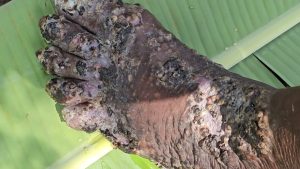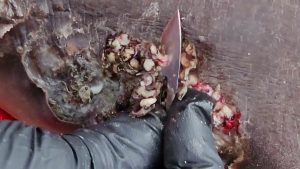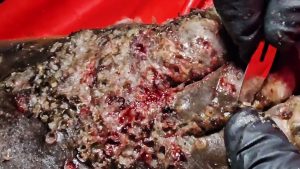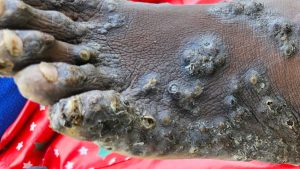

When done locally by the victims themselves, thorns are often used. Cleaned jigger sites display
deep pits on the skin (Image above, pg. 1, bottom: Reddit.com).
Jigger eggs hatch into larvae in about 3-4 days and feed on organic
matter and blood. Tunga penetrans has two larval stages before
forming pupae. The pupae are in cocoons. The larval and pupal
stages take about 3-4 weeks to complete. Afterwards, adults hatch
from pupae and seek out a capilliaries for blood meals “ (Centers for
Disease Control). In short:
• Tungiasis is caused by female sand fleas, which burrow into the skin and lay eggs.
• Tungiasis can cause abscesses, secondary infections, gangrene and disfigurement.
• The disease is found in most tropical and subtropical areas of the world; the poorest
people carry the highest burden of the disease.
• Both animals and humans are susceptible.2

IMPACT: Repeated infections mutilate the feet, hands, elbows, knees, of the infected people.
Impaired physical fitness of adult household members has a deleterious effect on life quality of
households. Children
afflicted with
tungiasis show inability
to walk, attend school,
play, or perform other
life-necessity and lifequality needs. Bacterial
superinfection may cause
other life-threatening
complications such as
blood poisoning,
erythema, (reddening of
skin) edema (excess
fluid in skin),
desquamation.3
Pain and
itching are a constant presence. Itching induces scratching of the lesion facilitating the shedding
of eggs, and pupae. Abscesses, sometimes large, are frequent. (Images Left: jigger-ahadi.org).

2 Tungsaisis is the medical term for jigger disease..
3 Diequalmification means rough scaly skin, often discolored—see picture above right.



